
Marycrest College Historic District is located on a bluff overlooking the West End of Davenport, Iowa, United States. The district encompasses the campus of Marycrest College, which was a small, private collegiate institution. The school became Teikyo Marycrest University and finally Marycrest International University after affiliating with a private educational consortium during the 1990s. The school closed in 2002 because of financial shortcomings. The campus has been listed on the Davenport Register of Historic Properties and on the National Register of Historic Places since 2004. At the time of its nomination, the historic district consisted of 13 resources, including six contributing buildings and five non-contributing buildings. Two of the buildings were already individually listed on the National Register.

The Fleur-de-Lys Studios, also known as Fleur-de-Lis Studios or Sydney Burleigh Studio, is a historic art studio, and an important structure in the development of the Arts and Crafts Movement in the United States. It is located at 7 Thomas Street in the College Hill neighborhood of Providence, Rhode Island. It was designed by Sydney Burleigh and Edmund R. Willson, and built in 1885. It was added to the National Register of Historic Places and designated a National Historic Landmark in 1992. In addition, it is part of the College Hill Historic District.

The John Brown House is the first mansion built in Providence, Rhode Island, located at 52 Power Street on College Hill where it borders the campus of Brown University. The house is named after the original owner, one of the early benefactors of the university, merchant, statesman, and slave trader John Brown. It was declared a National Historic Landmark in 1968. John Quincy Adams considered it "the most magnificent and elegant private mansion that I have ever seen on this continent."
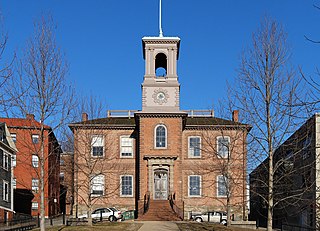
The Old State House on College Hill in Providence, Rhode Island, also known as Providence Sixth District Court House,Providence Colony House, Providence County House, and Rhode Island State House is located on 150 Benefit Street, with the front facade facing North Main Street. It is a brick Georgian-style building largely completed in 1762. It was used as the meeting place for the colonial and state legislatures for 149 years.

The Nightingale–Brown House is a historic house at 357 Benefit Street on College Hill in Providence, Rhode Island. It is home to the John Nicholas Brown Center for Public Humanities and Cultural Heritage at Brown University. The house is architecturally significant as one of the largest surviving wood-frame houses of the 18th century, and is historically significant as the longtime seat of the Brown family, whose members have been leaders of the Providence civic, social, and business community since the 17th century, and include nationally significant leaders of America's industrialization in the 19th century. The house was listed on the National Register of Historic Places and declared a National Historic Landmark in 1989.

The Corliss–Carrington House is a National Historic Landmark house at 66 Williams Street in the College Hill neighborhood of Providence, Rhode Island. Built in 1812, it is significant as a high-quality and well-preserved example of an Adamesque-Federal style town house.
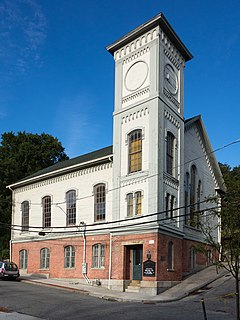
The Congdon Street Baptist Church is an historically African American church at 17 Congdon Street in the College Hill neighborhood of Providence, Rhode Island.

The Edward Dexter House is a historic house in the College Hill neighborhood of Providence, Rhode Island. It is a 2+1⁄2-story wood-frame structure, built in 1795–1797, with a hip roof topped by a square monitor. Its main facade is five bays wide, with the center bay flanked by two-story pilasters and topped by a small gable pediment. The well-preserved interior provided a template for an early-20th-century museum space designed by the Rhode Island School of Design to house a furniture collection donated by the house's then-owner, Charles Pendleton. The house is one of the few 18th-century houses in the city's College Hill neighborhood. It was originally located at the corner of George and Prospect Streets; in 1860 it was sawed in half and moved in sections to its present location.

The Hay and Owen Buildings are a pair of historic commercial buildings in Providence, Rhode Island.

The Providence Telephone Company is an historic commercial building at 110–116 Union Street in downtown Providence, Rhode Island. Now a five-story brick, stone, and terracotta structure, it was built with three stories in 1893 to a design by Stone, Carpenter & Willson. The street level facade is limestone, with a three-part entrance bay and two smaller flanking bays. The entrance bay is partitioned by Ionic columns, and the smaller outer bays are flanked by Corinthian columns. A complex entablature of grotesquework separates the second and third floors. The fourth and fifth floors, added in 1906, are more simply treated, with a simple parapet at the top. The Providence Telephone Company, incorporated in 1880, occupied this building from its construction until 1917, by which time its rapid growth had outgrown the building's capacity.
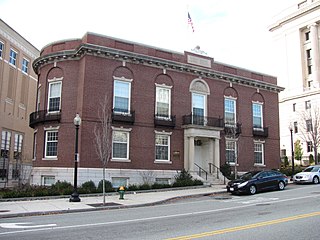
The Rhode Island Medical Society Building is a historic commercial building in Providence, Rhode Island. It is a two-story brick Federal Revival building, designed by Clarke, Howe & Homer, and built in 1911–12. It has a five-bay main facade and a bowed south-facing bay. The main entrance is recessed under a cast-stone entryway. The Rhode Island Medical Society was founded in 1812, and is one of the oldest medical societies in the nation. The building served as their headquarters from 1912 to 2002. The building was renovated in 2010 and is now occupied by Moran Shipping Agencies Inc.

The Rochambeau Library—Providence Community Library is an historic public library building at 708 Hope Street in Providence, Rhode Island. It is a single-story brick structure with limestone trim, designed by Wallis E. Howe and built in 1930. It has a symmetrical main facade, with the entrance in the center, sheltered by a porch supported by fluted Corinthian columns. The flanking bays are pavilions with gable fronts. A modern two-level addition with a glass front has been made to the north side of the building.

Shakespeare Hall is an historic commercial building at 128 Dorrance Street in downtown Providence, Rhode Island. It is a six-story masonry structure, originally built as a three-story Greek Revival structure in 1838 to a design by Tallman & Bucklin. Its main facade has retained the massive granite pilasters and five-bay configuration from this period. Originally built to house a theater, the building suffered a massive fire in 1844, leaving only its exterior shell standing. It was afterward rebuilt to its present height, and a separate brick building at its rear was incorporated into its structure in the late 19th century. It was used as a warehouse in the 1860s, and has also housed light industrial operations. Today, the building is used largely for law office space.

The Sons of Jacob Synagogue is a historic synagogue at 24 Douglas Avenue in Providence, Rhode Island. It is a two-story brick structure, set on a raised basement. The main facade is three bays wide, with a pair of entry doors sheltered by a simple gable-roof portico. The building was constructed in two stages, 1906 and 1926, and is the major surviving remnant of what was once a large Jewish community in the Smith Hill neighborhood of Providence. The congregation which built it was formed in 1896 by Orthodox Jews who immigrated from Russia. The first stage of the building, its lower level, housed the congregation until it could raise funds to build the upper level, and was then used as a shul. The upper level was designed by Harry Marshak, a self-taught architect and builder born to immigrant Russian Jews, who was likely the first Jewish architect to work in the Providence area.
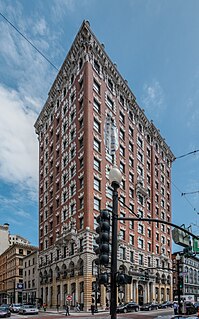
The Union Trust Company Building is a historic building at 170 Westminster Street and 62 Dorrance Street in downtown Providence, Rhode Island.

The Foster–Payne House is a historic house at 25 Belmont Street in Pawtucket, Rhode Island. Built in 1878, the two-story multi-gabled house is distinguished by its clapboarded and exterior woodwork and opulent parlors in the interior. The property also has a matching carriagehouse with gable roof and cupola. The house was originally constructed and owned by Theodore Waters Foster, but it was sold to George W. Payne in 1882. The Foster–Payne House is architecturally significant as a well-designed and well-preserved late 19th century suburban residence. It was added to the National Register of Historic Places in 1983.
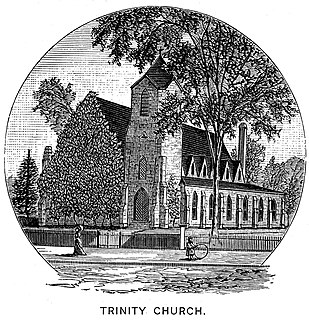
Trinity Episcopal Church was a historic church located at 48 Main Street in Pawtucket, Rhode Island. Built by the Episcopalians, the building was sold to the Catholics in 1977 and became the St. George Maronite Catholic Church within the Diocese of Providence. The church burned down in 2005, and was not rebuilt.

The Cary Building is a commercial building located at 229 Gratiot Avenue in Downtown Detroit, Michigan. It was listed on the National Register of Historic Places in 1983.

The Franklin Block is a historic commercial building at 75 Congress Street in downtown Portsmouth, New Hampshire. Built in 1879, this three-story brick building is the largest Victorian-era building standing in the city. It occupies the city block between Fleet Street and Vaughan Mall, a former street that is now a pedestrian mall. It was listed on the National Register of Historic Places in 1984.
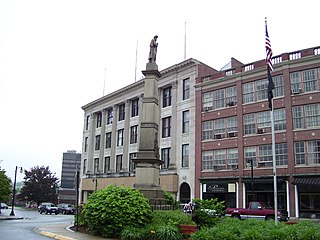
The L'Union Saint Jean-Baptiste d'Amerique is a historic building at 1 Social Street in Woonsocket, Rhode Island. Built in 1926, it housed a fraternal benefit society for French Canadian Roman Catholic immigrants for many years, serving a significant immigrant population in the community. The building is also a prominent example of Classical Revival architecture, designed by a French Canadian immigrant architect, Walter Fontaine. The building was listed on the National Register of Historic Places in 2018.























